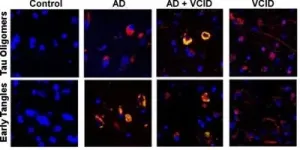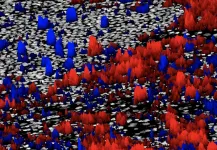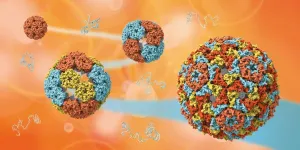(Press-News.org) Chestnut Hill, Mass. (6/10/2021) - A British man who rejected the standard of care to treat his brain cancer has lived with the typically fatal glioblastoma tumor growing very slowly after adopting a ketogenic diet, providing a case study that researchers say reflects the benefits of using the body's own metabolism to fight this particularly aggressive cancer instead of chemo and radiation therapy.
Published recently in the journal Frontiers in Nutrition, the report is the first evaluation of the use of ketogenic metabolic therapy (KMT) without chemo or radiation interventions, on a patient diagnosed with IDH1-mutant glioblastoma (GBM). Ketogenic therapy is a non-toxic nutritional approach, viewed as complementary or alternative, that uses a low-carbohydrate, high-fat diet to manage a range of cancers, including glioblastoma.
In this particular case, the patient's tumor contained a mutation, known as the IDH1. This mutation is acquired by chance and is known to improve overall survival. So the findings are particularly relevant to other patients whose tumors contain this mutation, according to Boston College Professor of Biology Thomas Seyfried, a co-author of the report and a leading researcher who has long advocated the benefits of KMT to treat disease.
"As GBM, like most malignant cancers, is dependent on fermentation for energy synthesis and survival, the simultaneous restriction of fermentable fuels, such as glucose and glutamine, while elevating non-fermentable ketone bodies, offers a non-toxic therapeutic strategy for managing GBM," said Seyfried. "Further studies will be needed to test this hypothesis in other patients diagnosed with GBM."
Glioblastoma kills about 15,000 people each year and remains largely unmanageable. While the standard of care has shifted to new immuno-therapies, the median survival time of 11 to 15 months for GBM has not improved significantly for more than 100 years, according to the co-authors.
A number of high-profile cases have illustrated the deadly progression of GBM. The late U.S. Sen. John McCain was diagnosed at age 80 with glioblastoma in July 2017, and died in August 2018. U.S. Sen. Edward M. Kennedy lived for a year after his diagnosis with GBM, dying at age 77. Beau Biden, son of U.S. President Joe Biden, was diagnosed at age 44 with GBM in August 2013, and died in May 2015.
The current standard of care for GBM involves surgical resection, radiation, and chemotherapy, which have been shown in studies to result in significant toxicity. However, large-scale clinical trials for alternative therapies are difficult to initiate, leading researchers to carefully examine individual cases.
The patient in this case was diagnosed with glioblastoma in 2014 and eschewed the traditional standard of care and instead embarked on a self-directed ketogenic diet -- low in carbohydrates and high in fat -- in an effort to manage his cancer.
The researchers found "the patient's tumor continued to grow very slowly over a three-year period without expected vasogenic edema until 2017," according to Seyfried and his co-authors, Boston College researcher Purna Mukherjee, Aditya Shivane, MD, of University Hospital Plymouth NHS Trust, in the United Kingdom, U.S.-based nutritionist Miriam Kalamian, Joseph Maroon, MD, of the University of Pittsburgh, and Giulio Zuccoli, MD, of the Drexel University School of Medicine
At that point, the patient underwent "surgical debulking" of his tumor. The pathology specimen confirmed the diagnosis of GBM and that the patient's tumor also contained the IDH1 mutation.
"Following surgery, the patient continued with a self-administered ketogenic diet to maintain low Glucose Ketone Index (GKI) values, indicative of therapeutic ketosis," the researchers report. "In light of continued slow progression of the residual tumour, the patient intensified his KMT starting in October, 2018 with inclusion of mindfulness techniques to reduce stress. While Magnetic Resonance Imaging (MRI) shows slow interval tumor progression, the patient remains alive with a good quality of life at the time of this report." He is now at 82 months from original diagnosis.
"We were surprised to discover that KMT could work synergistically with the IDH1 mutation to simultaneously target the two major metabolic pathways needed to drive the growth of GBM," said Seyfried. "Glucose drives the glycolysis pathway, while glutamine drives the glutaminolysis pathway."
He added: "No tumor, including GBM, can survive without glucose and glutamine. Our study has identified a novel mechanism by which an acquired somatic mutation acts synergistically with a low carbohydrate, high fat diet to provide long-term management of a deadly brain tumor."
Despite the compelling interest in such individual case studies, the co-authors note: "We cannot predict if the therapeutic response to KMT seen in our GBM patient will also be seen in other similarly treated GBM patients. For those GBM patients not fortunate enough to have acquired the spontaneous IDH1 mutation in their tumour, glutamine targeting drugs used with KMT will be necessary to reduce tumour growth."
The researchers noted that additional studies they've conducted have shown that the simultaneous targeting of glucose and glutamine availability, using KMT and the a pan-glutaminase inhibitor - known as 6-diazo-5-oxo-L-norleucine (DON) - can significantly prolong survival in preclinical syngeneic glioblastomas in mice. Earlier research has shown that ketogenic diets can facilitate delivery of small-molecule therapeutic drugs through the blood brain barrier without toxicity.
INFORMATION:
Just as the governor announced the start of python hunting season in Florida this month, researchers at the University of Central Florida have published a first- of-its-kind study that shows that near-infrared (NIR) spectrum cameras can help hunters more effectively track down these invasive snakes, especially at night.
The snakes, which can reach 26 feet in length and 200 pounds, have invaded the Everglades in Florida -- threatening native species and disrupting the ecosystem. The number of common native species observed in the Everglades since the snakes were first discovered in the 1990s dropped in some species by 90% through 2010, according ...
ITHACA, N.Y. - Researchers from Cornell University's School of Applied and Engineering Physics and Samsung's Advanced Institute of Technology have created a first-of-its-kind metalens - a metamaterial lens - that can be focused using voltage instead of mechanically moving its components.
The proof of concept opens the door to a range of compact varifocal lenses for possible use in many imaging applications such as satellites, telescopes and microscopes, which traditionally focus light using curved lenses that adjust using mechanical parts. In some applications, moving traditional glass or plastic lenses ...
Climate change exerts great pressure for change on species and biodiversity. A recent study conducted by the University of Helsinki and the Finnish Environment Institute indicates that the few moth and butterfly species (Lepidoptera) capable of adjusting to a changing climate by advancing their flight period and moving further north have fared the best in Finland. In contrast, roughly 40% of Lepidoptera species have not been able to respond in either way, seeing their populations decline.
Climate change is bringing about rapid change in Finnish nature - can species keep up with the pace? Adjusting to climate change can manifest through earlier phenology such as moth and butterfly flight periods, bird nesting, or ...
Researchers remain perplexed as to what causes dementia and how to treat and reverse the cognitive decline seen in patients. In a first-of-its-kind study, researchers at the Medical University of South Carolina (MUSC) and Beth Israel Deaconess Medical Center (BIDMC), Harvard Medical School discovered that cis P-tau, a toxic, non-degradable version of a healthy brain protein, is an early marker of vascular dementia (VaD) and Alzheimer's disease (AD). Their results, published on June 2 in Science Translational Medicine, define the molecular mechanism that causes an accumulation of this toxic protein. Furthermore, they showed that ...
WACO, Texas (June 9, 2021) - Most people listen to music throughout their day and often near bedtime to wind down. But can that actually cause your sleep to suffer? When sleep researcher Michael Scullin, Ph.D., associate professor of psychology and neuroscience at Baylor University, realized he was waking in the middle of the night with a song stuck in his head, he saw an opportunity to study how music -- and particularly stuck songs -- might affect sleep patterns.
Scullin's recent study, published in Psychological Science, investigated the relationship between music listening and sleep, focusing on a rarely-explored mechanism: involuntary musical imagery, or "earworms," when a song or tune replays ...
June 10, 2021, CLEVELAND: A new Cleveland Clinic-led study has identified mechanisms by which COVID-19 can lead to Alzheimer's disease-like dementia. The findings, published in Alzheimer's Research & Therapy, indicate an overlap between COVID-19 and brain changes common in Alzheimer's, and may help inform risk management and therapeutic strategies for COVID-19-associated cognitive impairment.
Reports of neurological complications in COVID-19 patients and "long-hauler" patients whose symptoms persist after the infection clears are becoming more common, suggesting that SARS-CoV-2 (the virus that causes COVID-19) may have lasting effects on brain function. However, it is not yet well understood how the virus leads to neurological issues.
"While some studies suggest ...
The human heart contracts about 70 times per minute, while that of a rat contracts over 300 times; what accounts for this difference? In a new study publishing 10th June in the open-access journal PLOS Biology, led by Michael Geeves and Mark Wass of the University of Kent and Leslie Leinwand from the University of Colorado Boulder, reveal the molecular differences in the heart muscle protein beta myosin that underly the large difference in contraction velocity between the two species.
Myosin is a "molecular motor" - an intricate nanomachine that forms the dynamic core of a muscle's contractile machinery, burning ...
Pairing sky-mapping algorithms with advanced immunofluorescence imaging of cancer biopsies, researchers at The Mark Foundation Center for Advanced Genomics and Imaging at Johns Hopkins University and the Bloomberg~Kimmel Institute for Cancer Immunotherapy developed a robust platform to guide immunotherapy by predicting which cancers will respond to specific therapies targeting the immune system.
A new platform, called AstroPath, melds astronomic image analysis and mapping with pathology specimens to analyze microscopic images of tumors.
Immunofluorescent imaging, using antibodies with fluorescent tags, enables researchers to visualize multiple cellular proteins simultaneously and determine their pattern and strength of expression. Applying AstroPath, ...
The team say their findings have implications for the treatment of viruses in future.
Researchers from the Universities of York and Leeds, collaborating with the Hilvert Laboratory at the ETH Zürich, studied the structure, assembly and evolution of a 'container' composed of a bacterial enzyme.
The study - published in the journal Science - details the structural transformation of these virus-like particles into larger protein 'containers'.
It also reveals that packaging of the genetic cargo in these containers becomes more efficient during the later stages of evolution. They show that this is because the genome inside evolves hallmarks of a mechanism widely ...
The specific traits of a plant's roots determine the climatic conditions under which a particular plant prevails. A new study led by the University of Wyoming sheds light on this relationship -- and challenges the nature of ecological trade-offs.
Daniel Laughlin, an associate professor in the UW Department of Botany and director of the Global Vegetation Project, led the study, which included researchers from the German Centre for Integrative Biodiversity Research in Leipzig, Germany; Leipzig University; and Wageningen University & Research in Wageningen, Netherlands.
"We found that root traits can explain species distributions across the planet, which has never been attempted ...






